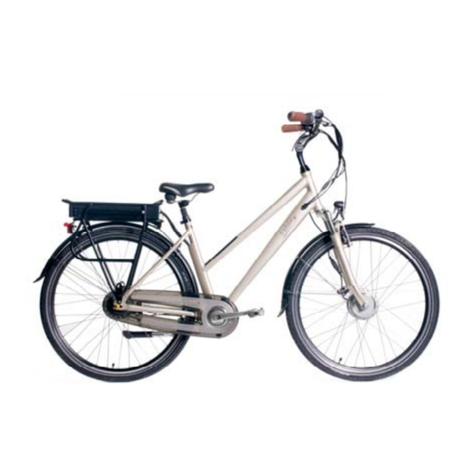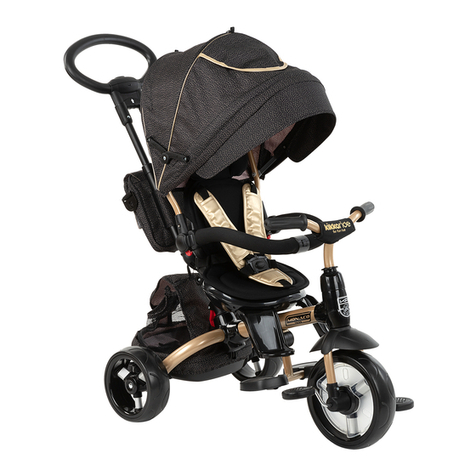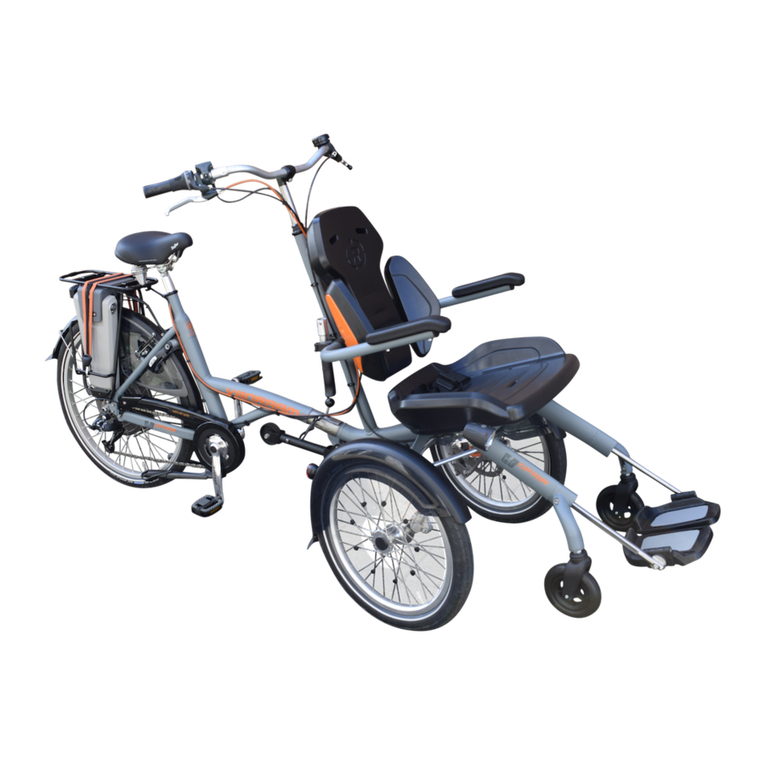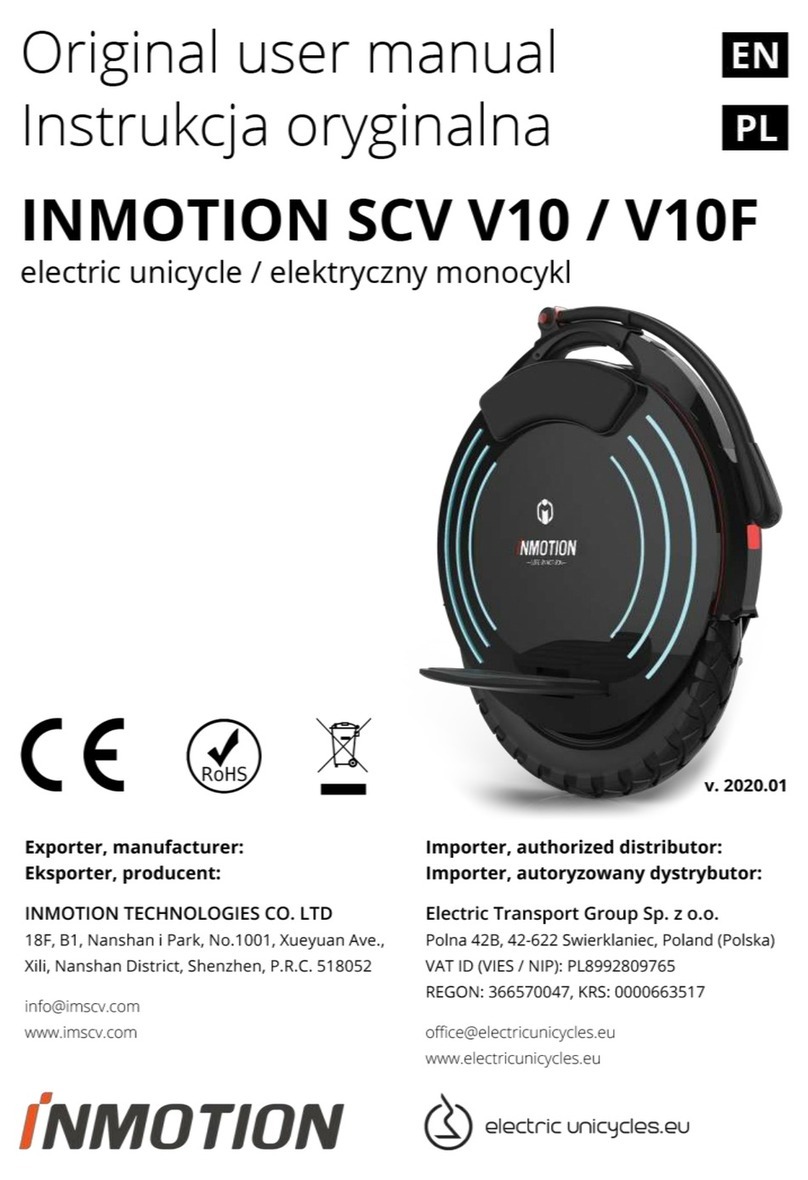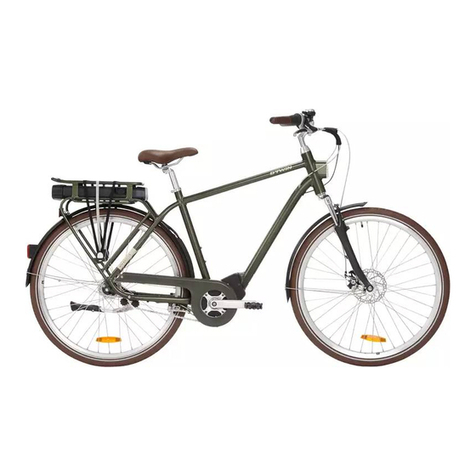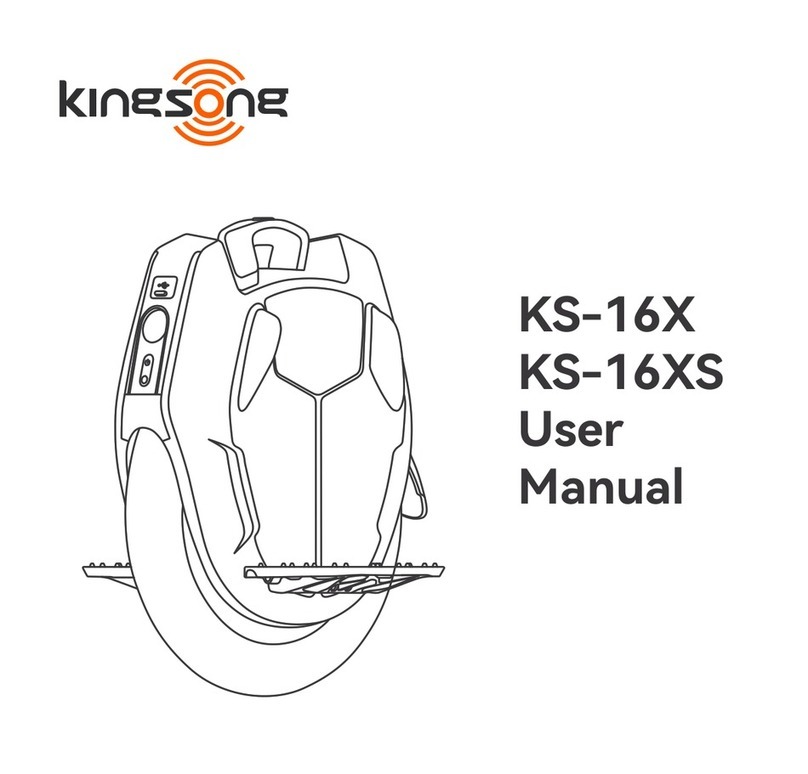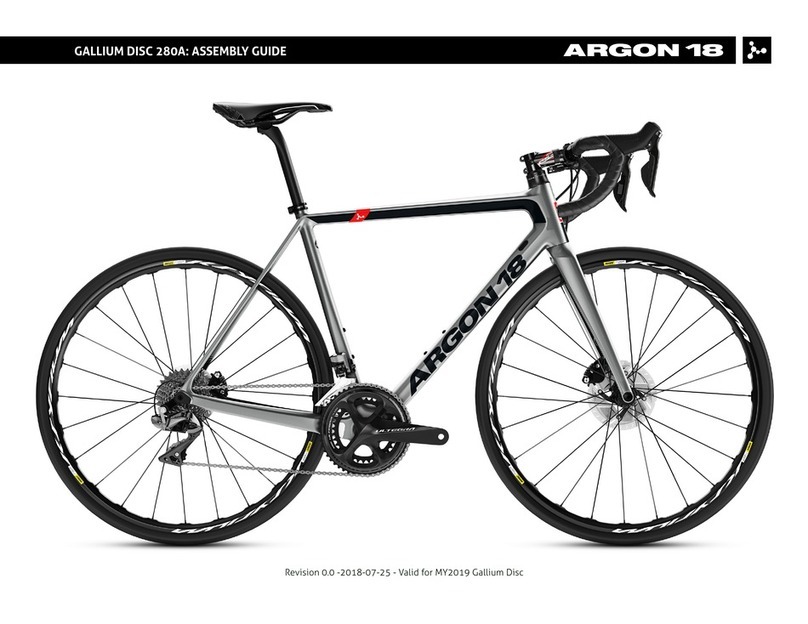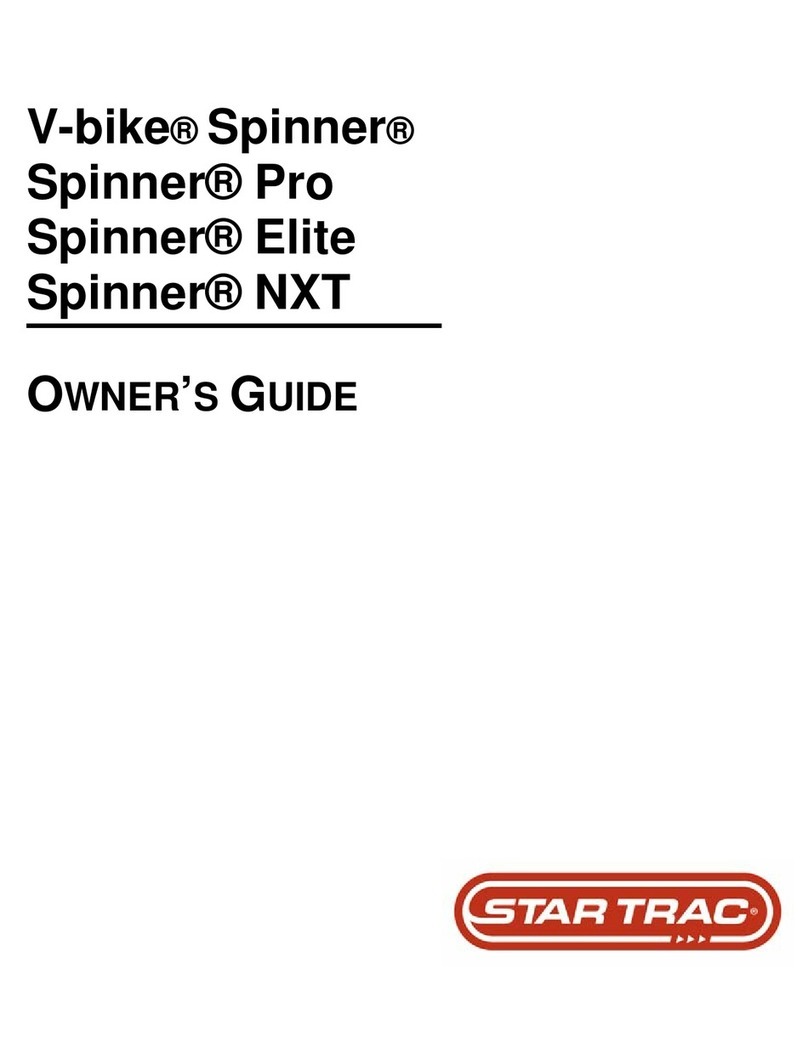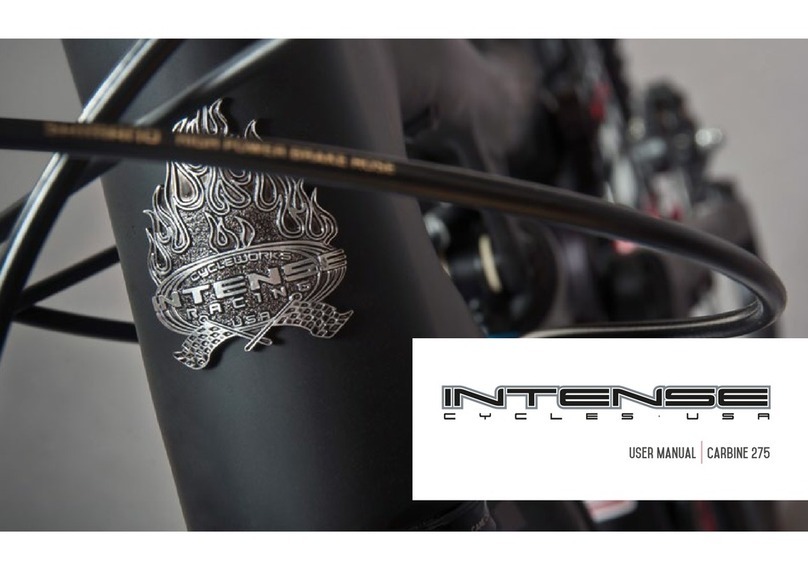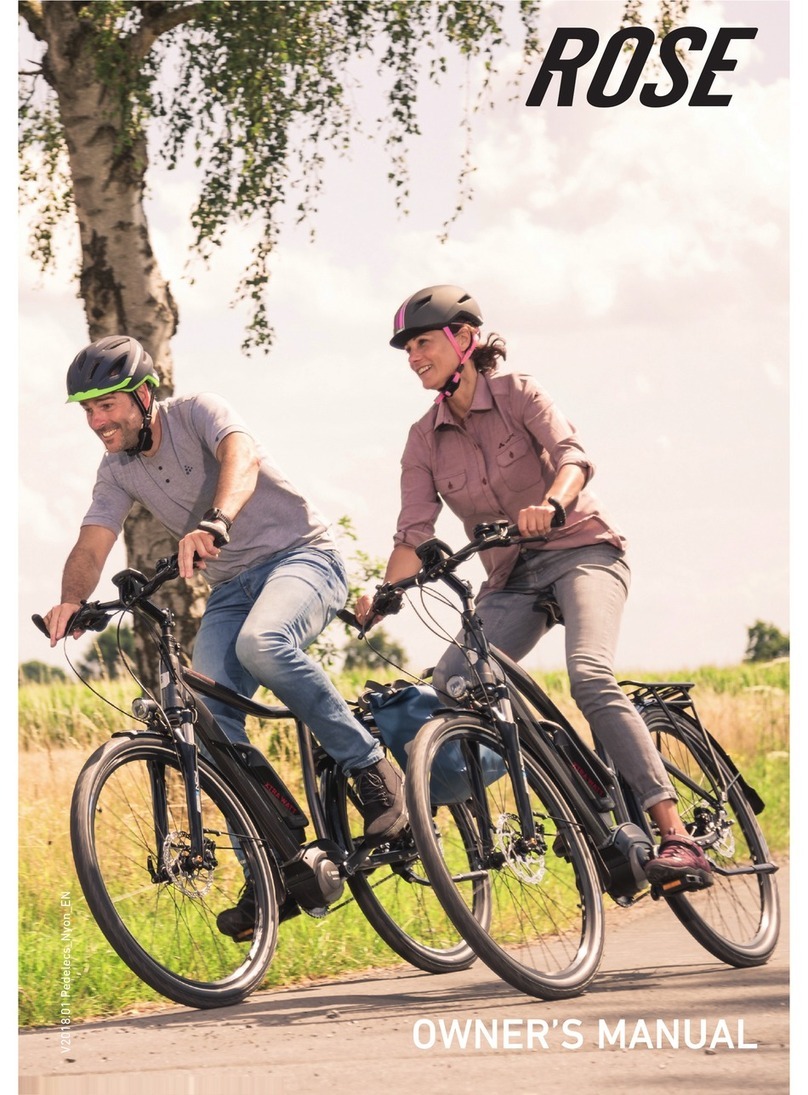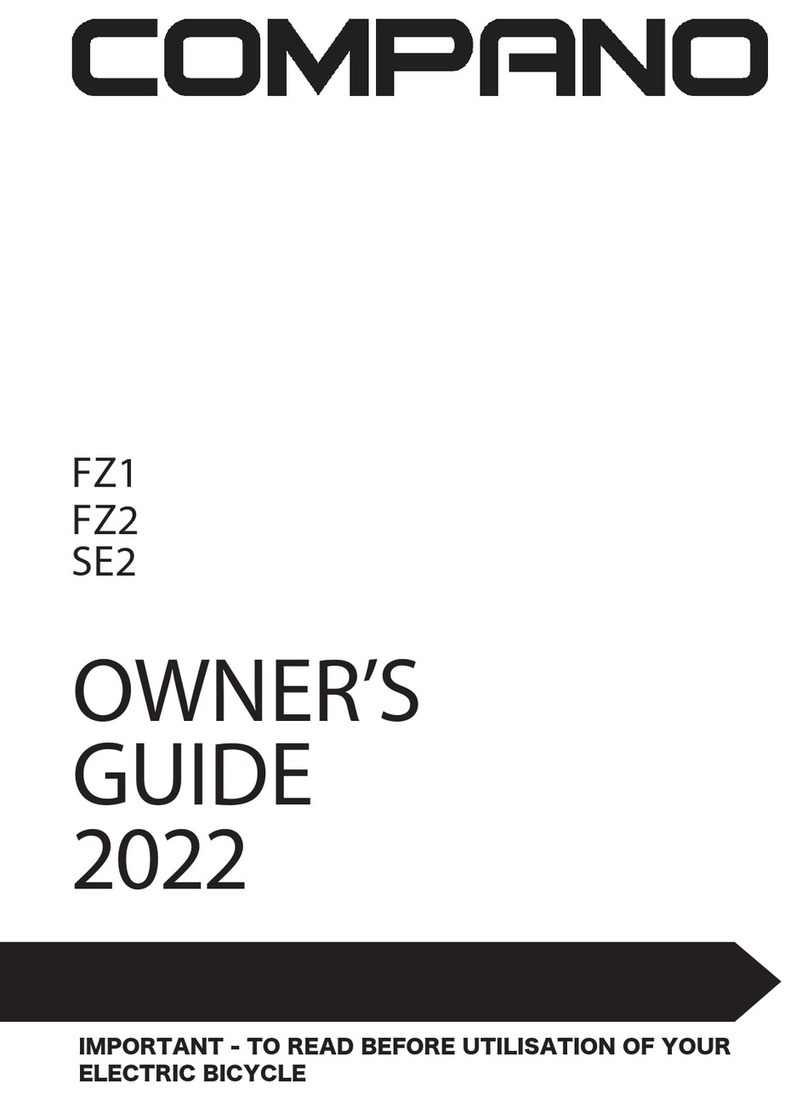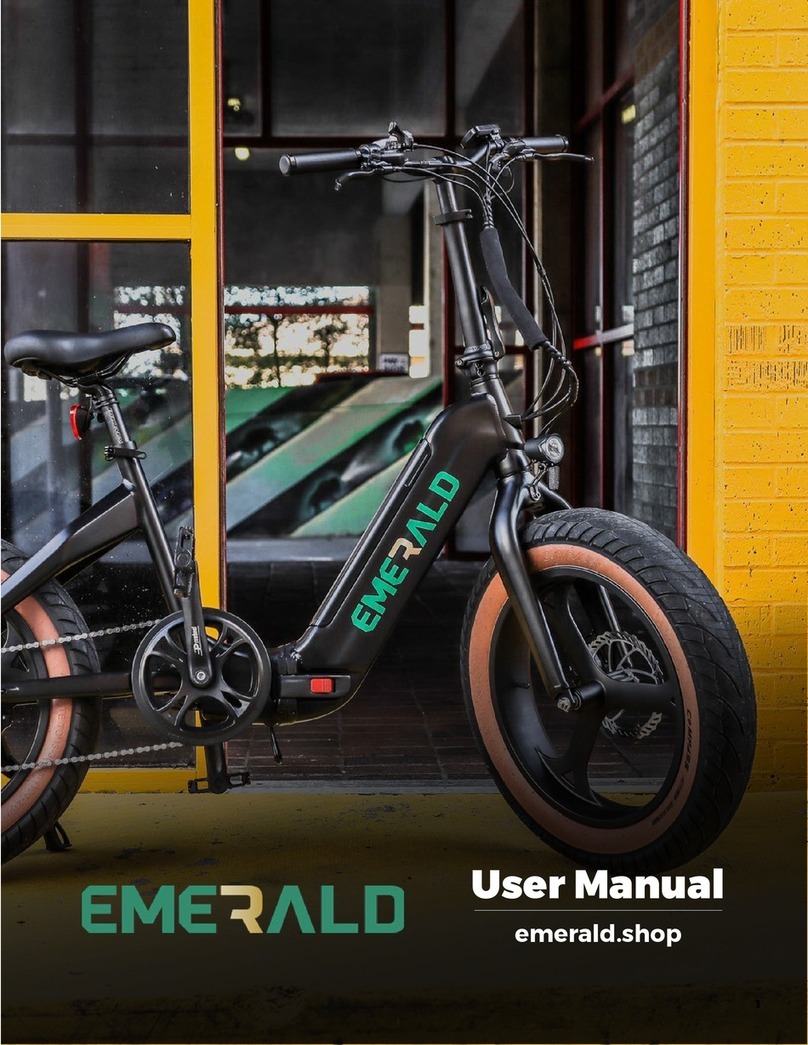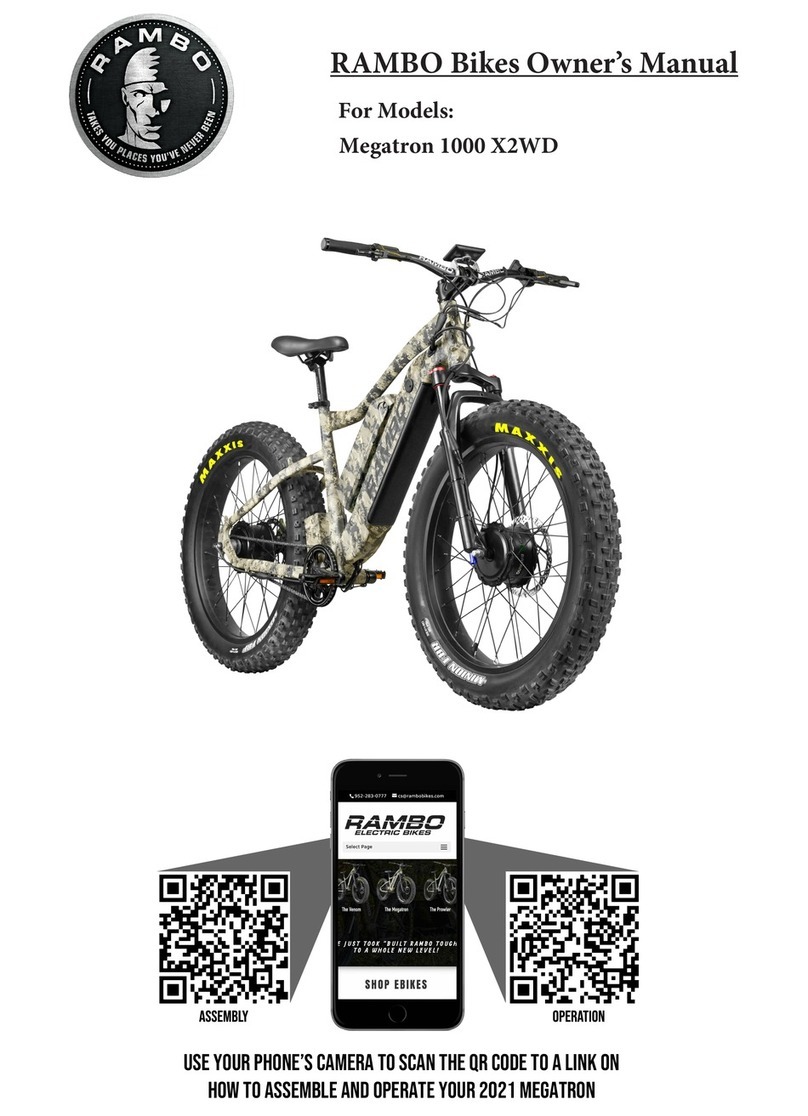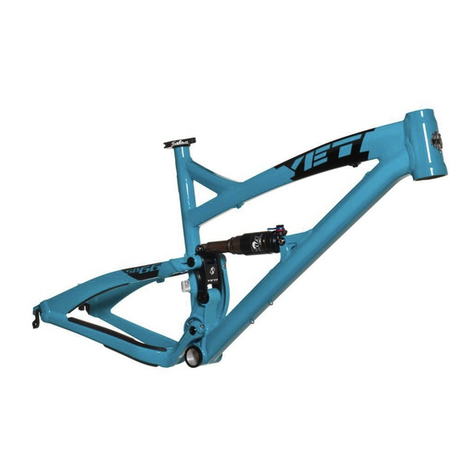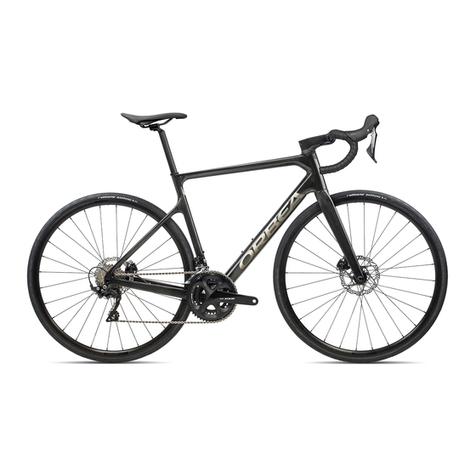BEEQ URBAN User manual

USER MANUAL A
USER MANUAL
GEBRAUCHSANWEISUNG
MANUAL DO UTILIZADOR
MANUEL DE L'UTILISATEUR
USER MANUAL GEBRAUCHSANWEISUNG MANUAL DO UTILIZADOR MANUEL DE L'UTILISATEUR


ENGLISH

4 USER MANUAL USER MANUAL 5
1. Índex 4
2. Preface 7
2.1. National Requirements 7
3. Basic Safety Information 7
3.1. Rider requirements 7
3.2. Intended Use 8
3.3. Emergency stop, emergency shut-o 9
3.4. Transport, Storage and Environmental Conditions 9
3.5. Total Weight Authorized on the bike 10
3.6. Child Seat and Bike Trailers 10
3.7. Check Before Use 11
4. The Bikes and its components 11
5. Adjusting your BEEQ ready to ride 14
5.1. Adjusting the Handlebars 14
5.2. Adjusting the Saddle 14
5.3. Adjusting the wheels 15
5.4. Adjusting the gear cables 16
5.5. Chain Tension 16
5.6. Brake Levers Position 17
5.7. Fitting the Pedals 18
5.8. Tightening torque values 18
6. Operation of the EPAC 20
6.1. Display 20
6.2. Walk assist mode (Sliding Aid) 20
6.3. Troubleshooting 20
7. Maintenance and Cleaning 21
7.1. Battery 21
7.2. Battery Charging 21
7.3. Using Original Parts 22
7.4. Maintenance 22
7.5. Maintenance of bike chains 23
7.6. Cleaning and Lubriication 23
7.7. Service and Maintenance Schedule 24
8. Errors and Troubleshooting 27
9. Emissions 28
10.Warranty 28
10.1. General warranty and guarantee conditions 28

6 USER MANUAL USER MANUAL 7
2. Preface
Thank you for purchasing your BEEQ!
This instruction manual is addressed at the riders and operators of the bikes as-
sisted by an electric motor described herein.
The bikes described in this instruction manual are assisted by an electric motor.
They correspond to the requirements of DIN EN 15194 Electrically power assisted
cycles, amongst others.
After turning on the bike, it assists according to the selected level only when you
pedal, it also as a mode for a walk-assist.
For safety reasons, it is most important that you read this User Guide BEFORE you
operate the bike. Improper handling can reduce its riding performance and most
importantly, pose danger to your safety and health!
For detailed operations for your BEEQ model, please refer to the online speciica-
tion (https://www.beeq-bicycles.com/the-range).
2.1. National Requirements
There may be deviating requirements for each country regarding the standard
features of bikes. In particular there may be speciic requirements regarding light-
ing, relectors and other components to be able to use the bike on the road. The
responsibility to comply with this regulation is to the rider.
3. Basic Safety Information
3.1. Rider requirements
There are no regulations to which riders of bikes assisted by an electric motor are
subject, so, in this case it’s recommended a minimum age of 15 years plus expe-
rience with pedal cycles.
The use of this bicycle must be done in strict compliance with the regulations in
force, in particular the Road Code.
In other respects, the rider must possess suicient physical and mental ability to
use a pedal cycle.
WARNING
USE YOUR BEEQ WISELLY, MAKE YOURSELF VISIBLE TO DRIVERS.
USE APROPRIATE CLOTHING AND WEARING A HELMET IS
STRONGLY RECOMMENDED AND OBLIGATORY FOR CHILDREN
UNDER 12 YEARS.
IN THE CASE OF A CRASH, PERFORM A FULL SERVICE ON YOUR
BIKE.
IF YOU DETECT A PROBLEM, DO NOT USE YOUR BIKE BEFORE
REPAIR.
CHECK YOUR BIKE BEFORE EACH USE.
READ THIS MANUAL CAREFULLY BEFORE THE FIRST USAGE OF
YOUR BEEQ, AND CHECK HOW TO SETUP AND MAINTAIN YOUR
EBIKE.
CONTACT YOUR BEEQ RETAILER FOR ADVICE.
GO OUT AND ENJOY YOUR BEEQ!!
For detailed operations for your BEEQ model, please refer to the
online speciication (https://www.beeq-bicycles.com/the-range).

8 USER MANUAL USER MANUAL 9
Changing settings and carrying out repairs to the bike shall only be deemed to be
in accordance with the intended use if they are carried out as described in this
instruction manual.
Adhering to the recommended operating, maintenance and monitoring meas-
ures, and reading, understanding and observing this instruction manual are all
deemed to be in accordance with the intended use.
3.3. Emergency stop, emergency shut-o
The bike does not have a separate emergency stop or emergency shut-o.
The power will shut o as soon as the force upon the pedals stops. The bike will
be mechanically braked or stopped with the brakes.
If the pushing aid is activated the drive is interrupted as soon as the correspond-
ing button is no longer pressed.
The drive system will not turn itself o during braking and thus remains availa-
ble at all times.
WARNING
When support mode is turned on the drive system reacts to the
smallest impulse introduced through the pedals.
Apply the brakes when getting to the bike to prevent an unin-
tended start and lower the risk of an accident.
The bike should only be turned on if the rider is able to brake, i.e.
can reach at least one brake
Do not perform work on the bike, without turning o the system.
3.4. Transport, Storage and Environmental
Conditions
During transport and storage, the bike must be kept upright. Lying the package
down or on end is not suicient to avoid damage to the frame and the wheels. The
bike must be kept dry during transport and storage. The drive battery, charger
and electronics of the bike require the temperature of storage to be kept at 5 °C
to 25 °C.
The temperatures of the motor, drive battery and charger are monitored. The drive
system turns itself o as soon as a temperature outside of the permitted temper-
ature range is reached.
3.2. Intended Use
To verify that the bike you just purchased corresponds to the usage that is intend-
ed, we have the following table that associates the bikes to a category of riding
conditions in order to use them in full safety. (According to Standard Classiica-
tion for Bicycle Usage ASTM 2043)
WARNING
The non-respect of the usage criteria described here can cause
risk to the user and a restriction of the warranty conditions.
CATEGORY TYPE OF USE MODELS
This is a set of conditions for the operation
of a bicycle on a regular paved surface
where the tires are intended to maintain
ground contact
Urban Models
This is a set of conditions for the operation
of a bicycle that includes Condition 1 as
well as unpaved and gravel roads and trails
with moderate grades. In this set of con-
ditions, contact with irregular terrain and
loss of tire contact with the ground may
occur. Drops are intended to be limited to
15cm (6”) or less.
Trekking Models
This is a set of conditions for operation
of a bicycle that includes Condition 1 and
Condition 2 as well as rough trails, rough
unpaved roads, and rough terrain and un-
improved trails that require technical skills.
Jumps and drops are intended to be less
than 61cm (24”).
Wild Models
Full Suspension
This is a set of conditions for operation
of a bicycle that includes Conditions 1, 2,
and 3, or downhill grades on rough trails
at speeds less than 40 km/h (25 mph), or
both. Jumps are intended to be less than
122cm (48”).
Non applicable

10 USER MANUAL USER MANUAL 11
Check the mounting options or consult your specialist. If the child seat is mount-
ed incorrectly a serious accident may occur.
Do not exceed the maximum permissible gross weight of the bike and the max-
imum load carrying capacity of the rear rack (If applicable). If you do, this could
damage the rear rack and frame and cause a serious accident.
3.7. Check Before Use
We’ve taken a lot of care during the assembly of your BEEQ, but parts may still
come loose or change of function during transportation for example.
You should therefore do a check of the following points:
• Is the tire pressure correct? (You can check the recommended tire pressure
engraved on the sidewall of the tires)
• Are the brakes working correctly?
• Are the batteries suiciently charged?
• Is the handlebar stem and seat post correctly inserted and tightened?
• Are the wheel hubs mounting nuts correctly tightened?
• Is there any screws, nuts and quick-release devices not properly tightened?
• Does the frame or fork present any deformation or damage?
• Is the bell working correctly?
4. The Bikes and its components
In order to understand this manual, it’s a good idea to know the components of
your bike and learn some bike vocabulary.
The following pictures describe the main components that equip your beeq.
Direct sunlight can lead to the temperature in the drive system signiicantly ex-
ceeding the permitted temperature.
WARNING
Do not expose the drive battery to permanent direct sunlight.
Higher temperatures can damage the drive battery and cause a
ire.
3.5. Total Weight Authorized on the bike
The total weight that a bike is authorized to carry includes the weight of the bike,
the weight of the rider, and the weight of luggage and accessories. You can ind
the information for your bike, label on the seat tube.
3.6. Child Seat and Bike Trailers
You can carry a child up to the age of seven years on the child seat. The rider must
be at least 16 years old. The total weight allowed must be respected.
WARNING
Only use child seats that satisfy the standard EN 14344.
These child seats must safely support the child’s feet.
Never leave your child unattended in the child seat when you
park your bike. The bike could fall over and severely injure the
child.
We do not recommend the use of bike trailers, the total weight
must be observed, the braking and handling can be seriously
aected.
When using a child seat/trailer, this adversely aects the han-
dling of the bike. The additional weight can cause the bike to
sway and signiicantly increases the braking distance. Adapt
your handling accordingly
If you change to a coil seatpost its recommended to cover any
coil springs under the saddle if a child-seat is itted to prevent
trapping of ingers.

12 USER MANUAL USER MANUAL 13
WILD
Figure 2 - Mountain pedelec example
N° Components N° Components
1 Saddle 7 Derailleur
2 Seat post 8 Cockpit (Stem & Handlebar)
3 Frame 9 Crank
4Integrated Battery HIDDEN
POWER 10 Motor
5 Chain 11 Fork
6 Cassette
URBAN/TREKKING
Figure 1- City/Trekking pedelec example
N° Components N° Components
1 Saddle 14 Front lighting
2 Seat post 15 Front mud guard
3 Luggage racks 16 Fork
4 Rear lighting 17 Fix for front mudguard
5 Rear mud guard 18 Tire
6 Cassette/Internal gear 19 Brake caliper
7 Kickstand 20 Disc Brake
8 Derailleur/Internal gear 21 Rim
9 Chain 22 Front mud guard
10 Chain guard 23 Integrated Battery HIDDEN
POWER
11 Motor 24 Pedal
12 Frame 25 Crank
13 Cockpit (Stem & Handlebar)
1 114 8
1312
25
15 9
16 10
17 11
18
19
20
21
22
23
24
2 2
3 3
4 4
5 5
6 6
7 7
8
9
10
11

14 USER MANUAL USER MANUAL 15
5.3. Adjusting the wheels
The wheels are fully tightened (in some models the front wheel is supplied disas-
sembled), if adjust is needed or you need to remove the wheel, tighten the screws
(or quick release) to make sure the front and back wheels are ixed to the front fork
and frame. Check torque table for values.
If a quick release is used, the minimum force to unlock should be at least 70Nm.
The correct position of quick release, when locked should be close to the frame/
fork with the mark “Close” visible.
THRUAXLE with Quick-Release/
Allen Key
1. Position the wheel on the drop-
outs
2. Slide the axle trough the hub
(lever in the open position)
3. Rotate the axle clockwise to
screw on the frame/for or n the
supplied nut (hold tight, no tools
needed), ind the best closing
force. (If it’s an Allen key tighten
to 10Nm and it’s done)
4. Open the lever to the angle of
45º before close
5. Choose the closing position. The
axle doesn’t rotate
6. Close the lever
7. The force required to close
should leave an imprint on your
hand
9mm Quick-Release
1. Position the wheel on the drop-
outs, the axle should be on the
wheel.
2. Rotate the axle clockwise, ind
the best closing force.
3. Close the lever
4. The force required to close
should leave an imprint on your
hand
5. Adjusting your BEEQ ready to ride
Every BEEQ is has its own features and geometry, next you may ind information
to help get it adjusted to each rider.
5.1. Adjusting the Handlebars
The handlebars will be initially adjusted for a general position. To reach a more
comfortable position, it is done by just loosing, adjusting and clamping the nec-
essary screw connection. The maximum torque on the clamping screws is 5Nm
to 7Nm, provided that the component does not indicate any other speciications
Please observe that when adjusting/changing the handlebar, the
response to steering and braking can be adversely aected.
5.2. Adjusting the Saddle
The saddle post must be inserted to at
least the circular safety mark engraved
on the tube.
Minimum insertion
An ideal saddle height is when the knee
is at a soft bend when you are sat on
the saddle with your foot on the pedal
at its lowest point. Adjust the saddle to
this height.
Saddle position
The saddle should be parallel to the ground for maximum comfort. The tight-
ening torque for the saddle mounting screw and saddle post mounting screw
should not be less than 18 Nm.

16 USER MANUAL USER MANUAL 17
5.6. Brake Levers Position
The brake levers come already assembled in an optimal position for the general
rider, but if you feel you need to adjust it, we advise to do as follows:
· Loosen the screws that hold the brake levers, then adjust the angle to a posi-
tion that best suits your needs in the riding position. (It’s recommended that
the ingers follow the same angle as the forearm)
· If needed adjust the distance of the brake lever to the grip, in order to use
the lever easily with two ingers (If feel more comfortable using three ingers
adjust accordingly)
Please note:
Right lever: Rear Brake
Left lever: Font Brake
Brake lever position
WARNING
Brake levers which push through the handlebar grip could
lead to you not being able to brake in time. This could result
in a fall or an accident. Check the brakes are working proper-
ly before each ride.
In wet weather conditions the braking distances increases.
Do not touch the braking rotors after heavy use, the disc will
be hot and may cause injuries.
To remove the wheel please do the reverse operation.
For detailed operations for
your BEEQ model, please
refer to the online speciica-
tion (https://www.beeq-bi-
cycles.com/the-range).
Quick release tightning
The recommended tire pressure is 2 bar, you can use a minimum of 1,5bar and the
maximum pressure engraved on the bike tire.
5.4. Adjusting the gear cables
The gears of our bikes are adjusted during the assembly, so, you should not need
to adjust it.
In the case the gears will not engage cleanly the settings in the gear lever housing
will need correcting. Unscrew the gear cable housing on the gear lever housing
by hand in small steps and check the functionality every time after a correction
has been made.
In order to turn the gear cable housing, it must be pulled out a little from its posi-
tion. Ensure that it is now sitting properly before testing the functionality.
If the gear cables cannot be adjusted in this way the assembly of the gear cables
should be checked by a trained technician.
For detailed operations for your BEEQ model, please refer to the online speciica-
tion (https://www.beeq-bicycles.com/the-range).
5.5. Chain Tension
The chain tension must be adjusted so that vertical play of one or two centimeters
is present in the unsupported chain span between the chainring and sprocket
wheel.
If play is veriied, to remove the slack, proceed as follows:
· Loosen the rear wheel nuts.
· Pull the wheel back into the dropouts until only the permissible amount of
play is present in the bike chain.
· Tighten all screw connections carefully clockwise.

18 USER MANUAL USER MANUAL 19
Component Screws and bolts Torque value
Transmission
Rear derailleur Fixation screw
Cable screw
Tension screw
810 Nm
67 Nm
34 Nm
Gear lever Fixation screw 5 Nm
Cassette Tightening screw 3545 Nm
Crank Fixation screw on motor axle 4550 Nm
Pedal Pedal axle 25 -30 Nm
Cockpit
Saddle on seat post Seat post with 1 itting block
Seat post with 2 itting blocks
1820 Nm
8 Nm
Seat post Seat post clamp 5 Nm
Stem Screw on the handlebar
Screw on the pivot
Angle screw
Screw on the stem cover
56 Nm
68 Nm
1415 Nm
45 Nm
Grips Fixation screw 3 Nm
Accessories
Classic luggage rack Fixation screw on the frame 810 Nm
Mud guard Fixation screw on the fork
Fixation screw on the support
Fixation screw on luggage rack/frame
5 Nm
3 Nm
5 Nm
Pedals Fixation on crank 1822 Nm
Kick-stand Fixation screw 1014 Nm
Brakes
Brake caliper Fixation screw on the frame/fork 68 Nm
Brake lever on handlebar Fixation screw on the brake lever 45 Nm
Disc brake Fixation screw on the hub
Centerlock lock ring
57 Nm
3545 Nm
Drive System
Crank Fixation screw on the motor 5764 Nm
Spider Fixation screw on the motor 2530 Nm
Chainring Fixation screw on spider 10 Nm
5.7. Fitting the Pedals
To install the pedals, please follow these steps:
· Apply a small amount of grease on the threads of each pedal
· Tighten the right pedal marked as “R” in a clockwise direction on the crank
of the drive side.
· Tighten the left pedal marked as “L” in a anti-clockwise direction on the
crank of the non-drive side.
· The recommended torque of the pedal is 30Nm.
WARNING
If you install clipless pedals, please refer to the manufactur-
er user manual for installation procedures.
Be sure you are familiar to the clipping and unclipping pro-
cess, there’s a risk of fall or injuries.
5.8. Tightening torque values
To guarantee the reliability of your bike, it is imperative that you tighten the screws
of all components carefully and regularly check them. Use a torque wrench in or-
der to check these values. Always tighten in a progressive manner in order not to
apply a torque higher than the recommended values.
Never go over the recommended maximum torque value in any case.
On some parts, the recommended torque values are indicated on the part itself.
Always respect these recommended levels. If you cannot ind the correct torque
rate for your component, check the speciic notice that was provided with your
bike, or ask your retailer for advice.

20 USER MANUAL USER MANUAL 21
7. Maintenance and Cleaning
7.1. Battery
The battery is one of the key elements of your BEEQ, and by following some sim-
ple rules you can optimize its lifespan:
· Do not stock your battery without any charge for prolonged periods; the battery
can go into a deep discharge which will shorten its lifespan.
· The battery can be stocked without use or charging for up to a year, but it must
be left charged to 70%.
· If stored for a long period of time, its recommended to charge it every 6 months.
· Even if it can bear being stocked in temperatures of -20°C to +60°C, you will
optimize its lifespan if you keep it at an ambient temperature (20°C).
· Respect the temperature conditions for usage which are -5°C to 40°C.
· Never leave your battery exposed to high temperatures or in direct sunlight for
a long period (for example in the back of a car in full sunlight).
· Ensure that the contact points are always clean and do not insert metallic ob-
jects.
· The battery is conceived in order to be recyclable.
· Do not throw them away in normal rubbish or the tip. There is a speciic treat-
ment (ask your local retailer for advice).
· Be careful, the transport of Lithium-ion batteries is subject to strict rules.
7.2. Battery Charging
The bike is supplied with a charger, which is designed to work with a 230 V and
50 Hz power supply and must not be used on any other. (Check the label on the
charger)
The ambient temperature must be within the range of 0 °C to 40 °C. The charger
will get very hot during charging. Ensure the charger is used in a clean and highly
inlammable environment.
WARNING
The drive battery may only be charged with the supplied charg-
er. Noncompliance can lead to a ire or explosion.
If moisture penetrates the charger there is a risk of electric
shock.
The charger’s power cable should be connected to a household earthed power
socket.
The charger’s cable is inserted into the charging socket of the drive battery on
6. Operation of the EPA
6.1. Display
The ebike is equipped with a display to switch the pedelec on and o, activate and
control support from the electric motor or switch on the headlights
For detailed operations for your model, please refer to the online speciication
(https://www.beeq-bicycles.com/the-range).
6.2. Walk assist mode (Sliding Aid)
The sliding aid is available for starting or pushing the wheel. The drive of the
pedelec supports the movement of the wheel. The sliding aid can be activated
up to a speed of < 6 km/h. You use the sliding aid when sliding the wheel, when
starting o or when assisted starting on a hill. If you push the wheel, you move
beside the wheel. Use the sliding aid as a starting aid when sitting on the bike. In
both cases, the activated sliding aid moves the pedelec.
WARNING
The sliding aid moves the pedelec. Grasp the handlebar grips and
be ready to apply the brakes. When sitting on the bike, do not press
the pedals. Your power and the sliding aid could accelerate the
pedelec very strongly. The second pedal also moves and can injure
you when you climb up! Do not use the sliding aid for slow driving.
For detailed operations for your model, please refer to the online speciication
(https://www.beeq-bicycles.com/the-range).
6.3. Troubleshooting
If the pedelec presents some kind of error, it will appear in the form of an error code.
For detailed operations for your model, please refer to the online speciication
(https://www.beeq-bicycles.com/the-range).
Note the error codes!
Error codes can indicate serious errors in the pedelec system. These
errors prevent safe operation of the pedelec. Accidents with per-
sonal injury and damage to the pedelec may occur. Stop using the
pedelec. Inform yourself about the meaning of the error code and
observe the solution approach. If the meaning of the error code is
unclear, stop the drive and turn o the wheel. Contact the manufac-
turer, the dealer or your garage for information on the next steps

22 USER MANUAL USER MANUAL 23
List of the dierent wear parts:
· Elements of the brakes (pads, discs).
· Tires, inner tubes, rims.
· Cables and cable hoses.
· Elements of the transmission (chain, chain ring, cassette, derailleur tension-
er, chain guide).
· Grips.
· Bearings.
· Freehub body
Regularly check all wear parts, especially parts for the brakes and the transmis-
sion in order to not take risks. If you have any doubt about the level of wear on any
part, please check the manufacturer’s notice or check with your retailer. Preven-
tion is better than cure, so don’t wait till the last moment!
7.5. Maintenance of bike chains
Bike chains are wear parts. Bike chains with hub gears wear out after roughly
2000km, and after roughly 1000 km with derailleur gears.
WARNING
If the bike chain is worn, it can break and cause a crash. If your
bike chain is worn, have it replaced by your specialist cycle
shop before using the bike again.
7.6. Cleaning and Lubriication
The bike must be protected against environmental inluences such as dirt, per-
spiration and salt when using the bike during winter or in the sea air. The bike
should be cleaned with a wrung-out cloth. A small amount of mild detergent may
be added to the cleaning water. Finally, the bike should be protected with a small
amount of maintenance product.
WARNING
It is always important to ensure that all friction surfaces of the
brakes do not come into contact with any lubricants or other
maintenance products.
If the disc pads are polluted, it can strongly reduce the braking
performance.
If brake pads are polluted, they must be replaced immediately.
the down tube. Mechanical encoding is used to ensure the connections are not
confused. The cable and the drive battery are magnetic and will guide the cable
into the correct position.
Charging will start automatically. The current battery status will be shown on the
display during charging. The battery status display will lash to show that it is
charging. The charger will lash infrequently to show that charging is ongoing.
Once the green indicator light is continuously displayed the battery is fully
charged.
Keep the drive battery and the charger away from children.
The statutory requirements regarding handling, transport and
disposal of the drive battery should be observed.
7.3. Using Original Parts
It is strongly recommended to use the original parts for all components that are
critical for safety.
The use of parts that are non-compliant with your bike, as well as any modiication
to the frame or parts can cause risks for the user of the bike as well as a restriction
of the guarantee.
If you wish to change your cranks to increase their length, you should irst check
that they will not pass too close to the chain stays. Please also check that your
shoe will not touch the wheel or the mud guard when the cranks are in a horizon-
tal position and you turn the handlebar. This same check should also be carried
out if you increase the width of the front tire.
What’s more, if you increase the length of your cranks, you will decrease their dis-
tance from the ground, so you are at risk of touching the ground if pedaling when
cornering or on rough terrain, and therefore risk a fall. Ask your retailer for advice.
7.4. Maintenance
The following inspection and servicing measures can be regularly carried out by
the operator/rider. If in doubt follow the advice of a specialist in a bike shop.
· Tire pressure should be adjusted to the rider preferences, with a minimum of
1,5bar and a maximum pressure marked on the side of the tire.
· Wear and tear on the tires should be inspected
· The drive chain and the chain rings should be cleaned with appropriate
cleaning agents and lubricated (Use speciic bike lubricants only)
· The gear cables should be checked and, if required, corrected
· Wear and tear on the brake pads and brake discs should be inspected
· Pressure in the suspension elements should be checked

24 USER MANUAL USER MANUAL 25
Component Action Before
every ride
Monthly Annually Other
Lightning Check function X
Tires Check pressure
Check tread and side walls
X
X
Brake cables/pads/lines Inspect visually X
Brakes (disc brakes) Check lever travel, brake pads,
seals, test brakes in stationary
Replace liquid (Use mineral
brake oil)
X
(b)
Suspension fork/rear
shock
Check recommendation from
manufacturer
Fork (rigid) Check for cracks and replace,
if needed
At least every 2
years
Bottom bracket Check for play
Dismount and re-grease
X
(b)
Chain Check and lube, if needed
Check wear and replace if
needed
X
(b)
Derailleur gears (b) after 900kms or
40 hours of use
Telescopic seat post Check recommendation from
manufacturer
Crank Check and retighten if needed X
WARNING
The electric drive system is only protected against ordinary
splashes of water. It must not be cleaned with high pressure
water devices, jets of water or compressed air.
This could result in a short circuit, loss of function, ire and ex-
plosion
7.7. Service and Maintenance Schedule
It is advisable to have your BEEQ serviced regularly after the bedding-in phase,
which is normal to occur, because of the relaxing of the cables tension, etc.. The
schedule given in the table below is a rough guide for cyclists who ride their
pedelec between 1,000 and 2,000 km or 50 to 100 hours of use a year.
If you consistently ride more or if you ride a great deal on poor road surfaces, the
service intervals will shorten accordingly.
If you have previous experience in bicycle mechanics, and have the appropriate
tools and lubricants/oils (for example: torque wrenches and bleeding kit for hy-
draulic disc brakes), you should be able to do the actions marked with X. If in this
case, you have any doubts or questions when encountering a defect or procedure,
please contact a specialized bicycle shop or dealer. The actions marked with (b)
are recommended to be performed at a specialized bicycle shop or dealer.

26 USER MANUAL USER MANUAL 27
8. Errors and Troubleshooting
The system will not turn on:
· Check the condition of the system
· Check if the charging socket is dirty (oil, grime) or if there is moisture pres-
ent. The system can only be turned on properly if the charging socket is
clean and dry.
· Check the battery charge level.
The system will not load
· Check if the charging socket and the cable are dirty
· Check if the positioning of the charging cable is correct
Speed is not shown correctly
· Check if the position of the magnet is correct
· Check if the speed sensor cable is defective
Motor does not provide suicient power/system range insuicient
· Ride until two charges are completely empty. Then constantly charge the
battery from 0% - 100% without interruption.
· For information:
· Take environmental inluences, itness condition and tire pressure
into account
· Optimal eiciency is between 7080 rpm
Support is intermittent whilst riding/the system
intermittently turns itself o during operation/
support is inconsistent
· Check if the position of the magnet is correct
Check the charging level of the battery
Magnet position
Should the error continue to manifest despite carrying out the
actions listed above please contact an authorized retailer.
Component Action Before
every ride
Monthly Annually Other
Painted/anodized/car-
bonsurfaces
Polish (b) every 6 months
Wheels/spokes Check wheel trueness and ten-
sion
True or retighten
X
(b) if needed
Hubs Check for play
Regrease
X
(b)
Handlebars and stem
(made of aluminum and
carbon)
Check and replace if needed (b) annually for MTB
and trekking, every
2 years for others
Headset Check for play
Regrease
X
(b)
Pedals (all) Check for play X
Pedals (clipless) Check for play
Regrease lock system
X
(b)
Seat post/stem Check tightness
Dismount and re-lubricate
Carbon: clean and apply new
assembly paste (NO GREASE)
X
(b)
(b)
Rear derailleur Clean and lubricate X
Quick release/thru-axle Check tightness X
Cables (gear/brakes) Disassemble and lubricate
Replace if needed
(b)
(b) annually for MTB
and trekking, every
2 years for others

28 USER MANUAL USER MANUAL 29
Warranty exclusions
Our warranty does not cover:
• Regular inspections, maintenance and repair or replacement for parts after
normal wear and tear
• The replacement, repair or delivery of consumables
• Troubleshooting of any type of software parts subject to wear and tear, con-
sumables and accessories used with this product
• The repair of defects caused by changes made to the product without our per-
mission.
• Adaptations of the products to technical and/or safety norms or standards
which are necessary because the product does not comply with the safety
norms or standards in the country of use outside the country of purchase or
because of changes to these safety norms or standards after purchase
• Compensation for damage caused because the product does not comply with
the technical standards and norms given in the country of use outside the
country of purchase.
A warranty repair is not transferable, means it if the product has been resold pri-
vately in the meantime (warranty applies only to irst buyers) and if errors or dam-
age have been caused by:
• Improper handling, excessive use or handling or operation of the product in a
manner inconsistent with the instructions contained in the operating instruc-
tions or manuals for the operating personnel and or relevant user documents,
including but not limited to improper storage, falls or severe vibrations;
• Corrosion, dirt, water or sand;
• Repairs or modiications carried out by an unauthorized specialist workshop;
• Use of spare parts that are not suitable for the product.
• Connection of the product to equipment not intended for this connection
• Insuicient packaging when shipping the product to an authorized service
center;
• Accidents, natural disasters and all other causes that we cannot control or fore-
see, including, but not limited to lightning, water, ire, sedition and inadequate
ventilation and air conditioning.
9. Emissions
The electromagnetic compatibility protection requirements are complied with in
accordance with DIRECTIVE 2014/30/UE. The bike and the charger may be used
in residential areas without restriction. The A-weighted emission sound pressure
level is lower than 70 dB (A).
10. Warranty
10.1. General warranty and guarantee conditions
We guarantee that the system-integrated components are free of defects
within the warranty period. If, exceptionally, a defect should occur in the
components during this time, it will be repaired free of charge. Free warran-
ty repair will only be provided upon presentation of the original invoice; pur-
chase receipt issued and stamped by the Seller, provided that the invoice con-
tains the name of the Buyer, the name and address of the Seller, the model
designation and, if applicable, the serial number of the purchased product and
the date of purchase. We reserve the right to refuse warranty repair if this infor-
mation is incomplete or has been subsequently removed or modiied. We also re-
serve the right to replace the defective product with another equivalent product
of the same or better quality as the defective product, instead of repairing the
defective product.
Warranty period
The warranty period is three (3) years from the date of purchase as evidenced by
the documents mentioned above.
Battery
For the battery the warranty is for three (3) years or 500 complete charging cy-
cles, whichever happens irst.
Use of the guarantee
The repair takes place in service points authorized by us. Any costs incurred for
the safe transport of the product to the service point and back shall be borne by
the purchaser.
Area of application
The scope refers to all countries of the European Union.

30 USER MANUAL USER MANUAL 31
Other
The repair may be delayed outside the original country of purchase if the repair
product is not yet sold there or is sold in a country-speciic version and as a result
certain spare parts for the product are not available in that country. We assume
no liability for further claims. This shall not apply where liability is mandatory, e.
g. in cases of intent, gross negligence, injury to life, limb or health, or breach of
fundamental contractual obligations. If the product is returned for warranty pur-
poses, the product must be carefully packed, insured and accompanied by proof
of purchase and a description of the defect. This guarantee does not aect the
respective country-speciic legal claims to which the buyer is entitled against his
seller in the event of defects, nor the rights to which the buyer is entitled in his
country from product liability against the manufacturer or other mandatory legal
norms. In the absence of national legislation to this eect, the buyer may rely sole-
ly on this warranty. Furthermore, neither we nor any other organization involved
shall be liable for any indirect or consequential damages arising out of any failure
to comply with any express or implied warranty of this product.

Deutsch

GEBRAUCHSANWEISUNG 3534 GEBRAUCHSANWEISUNG
1. Índex 34
2. Allgemeines 37
2.1. Ländervorgaben 37
3. Grundlegende Sicherheitshinweise 37
3.1. Fahreranforderungen 37
3.2. Bestimmungsgemäße Verwendung 38
3.3. Not-Stop, Not-Abschaltung 39
3.4. Transport, Lagerung und Umgebungsbedingungen 39
3.5. Für das Fahrrad zugelassenes Gesamtgewicht 40
3.6. Kindersitz und Fahrradanhänger 40
3.7. Vor Gebrauch prüfen 41
4. Die Bikes und ihre Komponenten 41
5. Einstellen Ihres fahrbereiten BEEQ 44
5.1. Einstellen des Lenkers 44
5.2. Sattel einstellen 44
5.3. Räder einstellen 45
5.4. Schaltzüge einstellen 46
5.5. Kettenspannung 46
5.6. Position der Bremshebel 47
5.7. Pedale einstellen 48
5.8. Anzugsmomente 48
6. Funktionsweise des EPAC 50
6.1. Display 50
6.2. Gehhilfe-Modus (Schiebehilfe)) 50
6.3. Troubleshooting 50
7. Wartung und Reinigung 51
7.1. Akku 51
7.2. Laden des Akkus 51
7.3. Verwenden Sie Originalteile 52
7.4. Instandhaltung 52
7.5. Wartung der Fahrradketten 53
7.6. Reinigung und Schmierung 54
7.7. Service- und Wartungsplan 54
8. Fehler und Störungsbehebung 57
9. Emissionen 58
10.Garantie 58
10.1. Allgemeine Gewährleistungs- und Garantiebedingungen 58

GEBRAUCHSANWEISUNG 3736 GEBRAUCHSANWEISUNG
2. Allgemeines
Übersetzung der Originalanleitung ins Englische.
Vielen Dank für den Kauf Ihres BEEQ!
Diese Bedienungsanleitung richtet sich an die Fahrer und Betreiber der Fahrräder,
die von einem hier beschriebenen Elektromotor unterstützt werden.
Die in dieser Bedienungsanleitung beschriebenen Fahrräder werden von einem
Elektromotor unterstützt. Sie entsprechen unter anderem den Anforderungen der
DIN EN 15194 Elektrisch unterstützte Zyklen.
Nach dem Einschalten des Fahrrads hilft es je nach gewählter Stufe nur beim Tre-
ten, es dient auch als Modus für einen Gehassistenten.
Aus Sicherheitsgründen ist es am wichtigsten, dass Sie diese Bedienungsanlei-
tung lesen, bevor Sie das Fahrrad bedienen. Unsachgemäßes Handling kann die
Fahrleistung beeinträchtigen und vor allem Ihre Sicherheit und Gesundheit ge-
fährden!
Ausführliche Informationen zu Ihrem BEEQModell inden Sie in der Online-Spezi-
ikation (https://www.beeq-bicycles.com/the-range).
2.1. Ländervorgaben
In anderen Ländern können abweichende Anforderungen an die Serienausstat-
tung von Fahrrädern bestehen. Insbesondere können spezielle Anforderungen
bezüglich Beleuchtung, Relektoren und andere Komponenten gestellt werden,
um das Fahrrad im Straßenverkehr verwenden zu können.
3.GrundlegendeSicherheitshinweise
3.1. Fahreranforderungen
Es gibt keine Vorschriften für Fahrer von Fahrrädern, die von einem Elektromotor
unterstützt werden. In diesem Fall wird ein Mindestalter von 15 Jahren sowie Er-
fahrung als Fahrradfahrer empfohlen.
Die Benutzung dieses Fahrrads muss unter strikter Einhaltung der geltenden Vor-
schriften erfolgen, insbesondere der Straßenverkehrsordnung.
Im Übrigen muss der Fahrer über ausreichende körperliche und geistige Fähig-
keiten verfügen, um ein Fahrrad zu fahren.
WARNHINWEIS
BENUTZEN SIE IHR BEEQ MIT BEDACHT, MACHEN SIE SICH FÜR AUTOFAHRER
SICHTBAR,
VERWENDEN SIE GEEIGNETE KLEIDUNG UND DAS TRAGEN EINES HELMES
WIRD DRINGEND
BEI KINDERN UNTER 12 JAHREN EMPFOHLEN.
FÜHREN SIE IM FALLE EINES UNFALLS EINE UMFASSENDE REVISION IHRES
FAHRRADS DURCH.
WENN SIE EINE AUFFÄLLIGKEIT FESTSTELLEN, BENUTZEN SIE IHR FAHRRAD
NICHT, SOLANGE ES NICHT REPARIERT WURDE.
PRÜFEN SIE IHR FAHRRAD VOR JEDEM GEBRAUCH
LESEN SIE DIESE ANLEITUNG SORGFÄLTIG VOR DEM ERSTMALIGEN GEB-
RAUCH IHRES BEEQ DURCH
UND CHECKEN SIE, WIE SIE IHR EBIKE EINSTELLEN UND PFLEGEN.
KONTAKTIEREN SIE IHREN BEEQHÄNDLER FÜR EINE BERATUNG.
NICHTS WIE HINAUS INS VERGNÜGEN MIT IHREM BEEQ!!
Ausführliche Informationen zu Ihrem BEEQModell inden Sie in der Online-Spe-
ziikation (https://www.beeq-bicycles.com/the-range).
This manual suits for next models
2
Table of contents
Languages:

